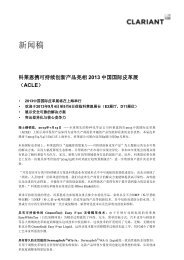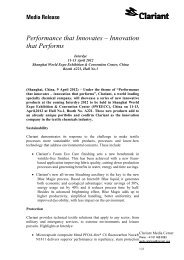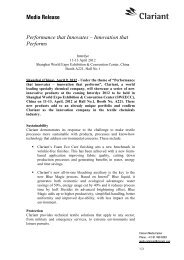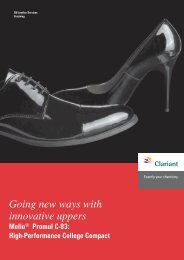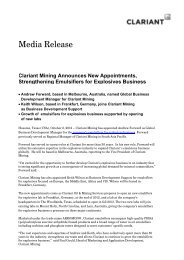CESA BROCHURE - Clariant
CESA BROCHURE - Clariant
CESA BROCHURE - Clariant
- No tags were found...
You also want an ePaper? Increase the reach of your titles
YUMPU automatically turns print PDFs into web optimized ePapers that Google loves.
MasterbatchesYour Added Protection<strong>CESA</strong> ® Additive Masterbatches
<strong>CESA</strong> ® Additive MasterbatchesThe technology leader in color andadditive concentrates for plastics,<strong>Clariant</strong> Masterbatches deliversinnovative performance solutionsto processors, resin manufacturersand end users around the world.Specified in virtually every majormarket and industry, <strong>Clariant</strong>’scomprehensive line of <strong>CESA</strong> additivemasterbatches offers unprecedentedopportunities to improve theproperties, performance and qualityof finished products, while alsooptimizing productivity and costs.The <strong>CESA</strong> product line includes anexceptionally broad selection ofstandard additive masterbatches foruse with all commercially availablepolymers. In addition, we can developcustom masterbatches as well asmasterbatches combining activeingredients with selected pigmentsand dyestuffs, in order to meet virtuallyany special customer requirement.With advanced technology,unparalleled creativity and globalexpertise, <strong>Clariant</strong> is uniquelypositioned to help our customersmake their products the very bestthey can be. Wherever you arelocated, however challenging yourapplication, you can rely on thehigh performance and consistentquality of <strong>CESA</strong> additive masterbatchesfrom <strong>Clariant</strong>.UV Stabilizers ..............................2Flame Retardants ...........................4Antistat, Antifog & Conductive ...............6Antiblock, Lubricants & NucleatingAgents . . . . . . . . . . . . . . . . . . . . . . . . . . . . . . . . . . . .8Infrared & Corrosion Inhibitors . . . . . . . . . . . . . .9Antimicrobials . . . . . . . . . . . . . . . . . . . . . . . . . . . .10Antioxidants ..............................12Drying Agents & Compatibilizers ............13Antislip & Fillers . . . . . . . . . . . . . . . . . . . . . . . . . .14Processing Aids, Mold Release,Cleaning Agents & RegrindOptimization . . . . . . . . . . . . . . . . . . . . . . . . . . . . . .15Laser Marking, Phosphorescents,Optical Brighteners & Opacifiers . . . . . . . . . . .16<strong>CESA</strong> Additive MasterbatchesProduct Line ..............................17
A Global Portfolio ofPerformance EnhancementsUV StabilizersLight radiation and oxygen in the air triggerdecomposition processes in plastics thatnot only change their appearance, butalso adversely affect their mechanicaland physical properties. Light stabilizersare used to protect plastics from discoloration,embrittlement and eventualdegradation caused by exposure toultraviolet light. Applications includeagricultural films, construction materials,lawn and garden equipment, signageand many other products used outdoors,as well as products exposed to fluorescentlight and filtered daylight indoors.Flame RetardantsFlame retardant additives make plasticssafer by making them more difficult toignite and by controlling their burningbehavior. Widely used in transportation,construction, appliance and electronicapplications, flame retardants helpmanufacturers meet UL and other regulatoryrequirements by minimizing flamepropagation, smoke and heat generation.AntistatsAntistatic agents prevent a buildup ofstatic electricity on polymer surfaces.Static charges not only attract dust anddirt, but can also cause sheet or filmto cling, stacked polystyrene cups tostick and powder to bridge. A suddendischarge can create sparks that maydamage products such as computerchips and also invite risk of explosion inhazardous areas. Antistats help avoidsuch problems, while also improvingprocessability and mold release.Antiblocking/Slip AgentsAntiblocking and slip agents modify thesurface of polymeric sheet or film, makingit rougher or more slippery. They areused to prevent thin films,sheets and thermoformedarticles from adheringto each other and to themetal surfaces of thermoformingequipment duringprocessing.Antislip AgentsFilled polyethyleneheavy-duty bags have atendency to slip and slidewhen stacked in layers,such as on pallets. Theaddition of antislip agentsimproves stackability byroughening the surfaceof the film, reducing itsslip properties.Corrosion InhibitorsTypically added to packaging films,corrosion inhibitors protect theappearance and extend the servicelife of metal parts and components.AntimicrobialsWithout antimicrobials, bacteria andspores can grow on the surface ofplastics, resulting in staining, odorand other undesirable characteristics,including premature product failure.Antimicrobials protect plastic film, fibersand molded products against bacterialgrowth, fungi, mold and mildew.AntioxidantsAntioxidants, often called heat stabilizers,are organic substances thatinhibit or retard polymer oxidation andits degrading effects. These includediscoloration, change in viscosity, lossof physical properties, loss of clarity,and surface crazing or cracking.Processing AidsLLDPE, LLPDE-rich blends and metalloceneresins are often extremelydifficult to extrude due to severeproblems with melt fracture duringprocessing. Processing aids aredesigned to coat the inner surface ofthe extrusion die, reducing frictionbetween the melt and the metal tofacilitate processing.Laser MarkingAlthough several laser sourcesare used to mark plastics, the mostcommon is the Nd-YAG system.Extremely flexible, it works byscanning or tracing, resulting in anexcellent fine and indelible print.1
UV StabilizersJust as unprotected human skinsuffers from sunburn due toexcessive ultraviolet radiation,plastics are also damaged byexposure to light.<strong>CESA</strong>-light UV stabilizers provideoutstanding protection against thedegrading effects of sunlight, heat andoxygen on the mechanical, optical andphysical performance of plastic parts.The <strong>CESA</strong>-light product family includesthree major classes of UV stabilizers:1 UV absorbers, which absorb harmfulUV radiation, dissipating it as “harmless”thermal energy. Widely used in food,drug and personal care packaging, theseactive ingredients perform best in productswith relatively thick wall sections,such as transparent blister packagingand hollow cosmetics tubes. Films,fibers and other products with thin crosssections will be afforded only limitedprotection by UV absorbers. 2 Nickel quenchers, which take overthe absorbed energy and dispose of iteither as heat, or as fluorescent orphosphorescent radiation. Their actionis independent of polymer thickness,and they are mainly used to stabilizepesticide-resistant agricultural films.3 Hindered amine light stabilizers(HALS), which do not absorb UVradiation, but act as radical interceptors,effectively inhibiting polymer degradation.Significant stabilization levels canbe achieved at relatively low concentrations,regardless of wall thickness.Although current understanding ofHALS is incomplete, it is believed thatthey convert nitro-oxyl free-radicalsunder photo-oxidative conditions andmay also cause the deactivation ofcarbonyl groups.2
HALS and UV absorbers are frequently used in combinationto achieve the highest possible levels of light protection.For example, <strong>CESA</strong>-light 7105 masterbatch, developed forstabilization of shrink film, is based on HALS, UV absorbersand antioxidants.UV TransmittanceAnother product, <strong>CESA</strong>-light NEA0050145, is a highly concentratedUV-absorber masterbatch developed for PET packagingto protect UV-sensitive ingredients in cosmetics, beveragesand other products. At 0.8% dosage, it offers an optimumbalance of price and performance.Light StabilizationThis test, indicating 50% retained elongation after accelerated exposure, was conducted using dosages of 1.5% and3% <strong>CESA</strong>-light 7101 in 100 µm LDPE film.3
Flame RetardantsSince almost all plastics arebased on hydrocarbons, they arecombustible.<strong>CESA</strong>-flam flame retardant masterbatcheshelp to protect people andproperty by delaying the spread of fireand toxic by-products and, in somecases, preventing ignition entirely.Unlike reactive flame retardants, whichare incorporated into the polymermolecule during polymerization, flameretardant masterbatches allow variabledosing levels and thus flexibility duringprocessing. The effects may be eitherphysical or chemical, occurring ineither the gaseous or solid phase.4
The most common flame retardantsinclude the following:1 The effectiveness of inorganichydroxides (such as magnesium hydroxideand aluminum trihydroxide) is basedon the dilution of the plastic as acombustible material – more specifically,on the dilution of the incendiary gasesand on the absorption of energy byendothermic reactions. Because of theirvery high dosage requirement (>50%),inorganic hydroxides are preferablyused in compounding.2 Halognenated flame retardants(e.g., brominated and antimony systems)actively intervene in the free-radicalbasedcombustion reactions in thegaseous phase and form less reactivebyproducts. This delays or interruptsauto-catalytic combustion. Highlyefficient, halogenated flame retardantadditives are especially suitable formanufacturing flame retardantconcentrates.3 Compounds containing phosphorous,which facilitate the formation of a protectivelayer of carbon via the phosphoricacid produced during a fire. These havespecific effects that are less universalin application.4 Intumescent systems, which causethe formation of a protective, ceramiclikelayer via a combination of activeagents (organophosphorous compoundscombined with a “foaming agent”).Intumescent systems also have limitedapplications.<strong>CESA</strong>-flam masterbatches offer a widerange of very efficient and universallyusable halogenated flame retardants,as well as some specific halogen-freesolutions. They are used primarily forextrusion and injection molding applicationsin LDPE, LLDPE, HDPE, PP, PS,ABS and engineering resins. A few<strong>CESA</strong>-flam grades have been specificallydeveloped for fiber applications.Flame RetardancyFlame-retardant ratingaccording to UL94 testingV-0V-1halogen-containingflame retardantsV-2non-classifiedhalogen-freeflame retardants01020 30Addition level of flame retardants (%)Denesting force (%)5100
Antistat, Antifog& ConductiveAntistatThe chemical structure of plasticsmakes them particularly susceptibleto buildup of electrical charges,which attracts dust and accumulatedstatic electricity. Eliminatingthe electric charges to maintain goodproduct appearance is a must forsuccessful marketing of food andcosmetics packaging. It is also criticalto protect sensitive electronicspackaging and to reduce a major firehazard in production environments.<strong>CESA</strong>-stat antistatic masterbatchesare formulated for use with virtually allpolymers in injection molded, blowmolded and extruded applications.They are easier to disperse uniformlythan antistatic agents in liquid or pasteform. The active ingredients of <strong>CESA</strong>statmasterbatches can also be combinedwith other additives and pigmentsin a single easy-to-use masterbatch.Antistatic agents are additives whoseefficiency is measured either bydetermining the surface resistivity orthe static decay. Without antistaticagents, the surface resistivity of plasticis typically between 10 14 to 10 15 ohms.Antistatic additives will lower thesurface resistivity to 10 9 to 10 12 ohms.In order to achieve a higher conductivity,conductive fillers such as carbonblack or carbon fibers or powderedmetal must be added to the plastic.6
AntifogFood packaging and horticultural filmsused with water-containing productsoften fog over on their inner surfacedue to the condensation of tiny dropletsof moisture. Droplets are particularlyundesirable in greenhouse films, wheregood light transmission is essential forcrop growth.<strong>CESA</strong>-nofog additive masterbatcheseliminate the problem by lowering thesurface tension of the water droplets,causing them to merge and form acontinuous transparent Half-time layer that charge maintainsdecay (sec.) electrical conductivity sometimesthe clarity of the 50 film. For example,<strong>CESA</strong>-nofog 2101 was developed > 180 forrestricts their area of application. Theuse of <strong>CESA</strong>-conductive compounds40LDPE and LLDPE food packaging film.It does not affect the transparency30ofthe film and withstands sudden temandmasterbatches improves electricalconductivity, enabling plastic parts,for example, to protect highly sensitiveperature variations.20electronic components from damagecaused by electrostatic discharge.10ConductiveConductive compounds are also0increasingly used in components forWhile the good insulation properties Without oftransporting1hazardous1.5materials.2polymers are desirable in a wideadditiverange<strong>CESA</strong>-stat 3101 (%)of applications, their typically very lowCharge DecaySurface ResistivityHalf-time charge decay (sec.)50> 180403020Surface resistivity (ohm)10 1310 1210 111 day after production14 days after production1010 100Withoutadditive1 1.5 2<strong>CESA</strong>-stat 3101 (%)10 9 34 6<strong>CESA</strong>-stat 3301 (%)This test was conducted using <strong>CESA</strong>-stat 3101 in LDPE injection molded plaques,1 mm in thickness, 3 days after manufacture.Surface resistivity (ohm)This test was conducted using <strong>CESA</strong>-stat 3301 in 1 mm molded plaques of HIPS, at 50%relative humidity, per test method ASTM D257.7
Antiblock, Lubricants& Nucleating AgentsAntiblock<strong>CESA</strong>-block antiblocking additivesmodify the surface characteristic bycreating a slight surface roughness orsmoother surface, thus reducing thecoefficient of friction. This preventsself-adhesion of plastic film or sheet,making it easier to handle. Typicalapplications include polyolefin filmsand polyester sheets used in foodpackaging.Depending on the grade specified,<strong>CESA</strong>-block provides very good dispersion,optical properties and efficientantiblocking effects even at low dosingratios. As an example, <strong>CESA</strong>-block 1102is a masterbatch containing effectiveactive substances in an LDPE carrier.Its good dispersion and small particlesize make it suitable for thin-gaugeapplications. The suggested dosageis 0.5 to 1%.Flame-retardant ratingaccording to UL94 testingV-0Nucleating Agents<strong>CESA</strong>-nucleant masterbatches aremainly used to clarify PP resin. Theyinfluence the degree of crystallinity ofpolymersV-1and increase hardness, tensilestrength, modulus of elasticity and yieldpoint, while also reducing cycle times.<strong>CESA</strong>-nucleant greatly improves opticalV-2properties such as transparency ortranslucency.Denesting force (%)100halogen-containingflame retardantsideal nucleating agent in direct gassedPS and polyolefin foams. The nucleatingeffect results in small cell sizes.HYDROCEROL nucleating agents areavailable for gassed foam extrusion inpowder and masterbatch form, in variousconcentrations and carrier systems.The optimal dosage of HYDROCEROLhalogen-freeflame retardants nucleating agents depends on thenon-classifiedChemical foaming agents, materials that desired foam quality and all the othergenerate 0 gas upon decomposition, 10 also variables 20 in the process. For optimization,a starting (%) dosage of 0.2 to 0.3%30act as nucleating agents. Addition The fine-grain level of flame retardants(based on active ingredient) has provento be favorable.spherulite structure of ingredients incorporatedin <strong>Clariant</strong>’s HYDROCEROL ®chemical foaming agent makes it anAntiblocking EfficiencyLubricants80<strong>CESA</strong>-slip lubricants improve the flowcharacteristics of plastics during processing.They also reduce the frictionalresistance of end-product surfaces,enhancing both appearance and function.In addition, <strong>CESA</strong>-slip masterbatchescan act as plasticizers and impactenhancers, as well as antiblock,antitack and antistatic agents.6040200Without antiblockingadditiveWith <strong>CESA</strong>-block 1501additive<strong>CESA</strong>-slip can be used in conjunctionwith other plastics additives includingrelease agents and heat stabilizers.For example, <strong>CESA</strong>-slip PEA0050534combines slip and antiblocking agentsin an LDPE carrier material. It improvesslip properties at a dosage of 1%.This blocking force test was conducted using <strong>CESA</strong>-block 1501 in PET film, 300 µm thick, use levels 0 and3.5% respectively.8
Infrared & CorrosionInhibitorsInfrared<strong>CESA</strong>-IR masterbatches have beendeveloped for use in agricultural thermalfilms. While maintaining transparency,they allow penetration of short-waveIR radiation coming from solar rays,yet prevent the emission of longer-waveIR radiation. This increases heatretention, supports plant growth andallows greenhouses to maintain anadequate temperature, even at night.Corrosion Inhibitors<strong>CESA</strong>-cor anticorrosion concentratesare used to protect ferrous and mostnon-ferrous metals from the deterioratingeffects of corrosion. Typical applicationsare films used for packaging ball bearings,automotive spare parts and othermetal components.When extruding PE film with <strong>CESA</strong>-cor,the active inhibitors are vaporized andwell dispersed. The film protects thepackaged part by condensing on thesurface of the metal.<strong>CESA</strong>-cor corrosion inhibitors arenitrite-free, have a neutral odor andproduce no adverse effects on theworking environment.9
AntimicrobialsMicroorganisms such as fungi andbacteria are present in all environments,although they are invisible tothe naked eye. The reproduction andgrowth of bacteria, fungi, mildew andmolds happen rapidly on plastic surfaces.<strong>CESA</strong>-antimicro masterbatches inhibitthe growth of these microorganisms,helping to prevent unpleasant odors,discoloration, and surface degradationof plastic parts.Typical applications for antimicrobialsinclude fibers and textiles used inathletic gear and household furnishings,kitchenware and bathroom products,automotive steering wheels and interiorparts, pharmaceutical and medicalproducts, and a spectrum of otherplastic applications requiring a highstandard of hygiene.There are two major types of antimicrobials,both of which are represented inthe <strong>CESA</strong>-antimicro product line. Organicantimicrobials consist of substancesthat migrate within the polymer matrix,spreading over the surface of the materialswhere their antimicrobial actionhas effect. Organic antimicrobials areeffective at low concentrations, offeringa favorable cost/performance ratio inpolymers that are processed at temperaturesnot exceeding 250˚C (482˚F).Inorganic antimicrobials incorporatesubstances containing silver in ionicform, bound to inorganic compoundsthat regulate the diffusion of ions withinthe polymer mass. The silver ion is theactive ingredient that interacts withbacteria. Non-toxic, non-corrosive andflameproof, inorganic antimicrobials haveno negative impact on plastics processing.They are highly recommended for objectsrequiring long-lasting antimicrobialaction and for engineering polymers thatare processed at high temperatures.<strong>Clariant</strong>’s wide range of <strong>CESA</strong>-antimicromasterbatches answers every requirementregardless of the resin or process.10
Number of bacteria4,000,0003,500,0003,000,000StartAfter 24 hours2,500,0002,000,0001,500,0001,000,000500,0000Antibacterial Effect on Plastic0 0.65 1.30 2.00 2.60Masterbatch dosage (%)Bacterial Growth on Plastic End ArticleNumber of bacteria4,000,0003,500,0003,000,0002,500,0002,000,0001,500,0001,000,000500,0000StartAfter 24 hoursNumber of bacteria5,000,0004,500,0004,000,0003,500,0003,000,0002,500,0002,000,0001,500,0001,000,000500,00000 0.65 1.30 2.00 2.60Masterbatch dosage (%)8 9 10 11 12Time (hours)Number of bacteria5,000,0004,500,0004,000,0003,500,0003,000,0002,500,0002,000,0001,500,00011
AntioxidantsOxidation and heat aging are majorcauses of degradation of plastics.Exposure to heat and oxygen causes achain reaction involving the formationof free-radicals, which inevitably leadsto cleavage of the main chains in thepolymer and degradation of the plastic.This is manifested in many differentways including loss of shine and transparency,yellowing, surface crackingand odors. Oxidation can also result inloss of mechanical properties such asimpact resistance, elongation andtensile strength.5<strong>CESA</strong>-nox antioxidant masterbatchesare formulated to combat thermo-oxidativedecomposition at every stage of theplastic life cycle, from manufacturing,drying and processing through end use.They are particularly suitable for use inLDPE, LLDPE, HDPE and PP. One exampleis <strong>CESA</strong>-nox 4201, a masterbatch basedon a combination of antioxidants forlong-term heat protection of polypropylenecaused by severe outdoor and/orheat exposure.4.543.5321without antioxidant 0.6% <strong>CESA</strong>-nox 41022 3Number of extrusionsAntioxidant Efficiency5Heat Aging TestHeat aging resistanceat 150°C (days)4.5without antioxidant0.6% <strong>CESA</strong>-nox 4102150.04100.03.5350.0212 3Number of extrusionsMultiple processing was performed by extrusion of LDPE at 240˚C, 0.6% <strong>CESA</strong>-nox 4102addition rate.0.01.2 2.5 5.0<strong>CESA</strong>-nox PP 41412 (%)Test at 150°C on 1 mm thick homopolymer PP plaquesEvaluation: embrittlement time (days)Heat aging resistanceat 150°C (days)150.012100.0
Drying Agents& CompatibilizersDrying Agents<strong>CESA</strong>-dry desiccant masterbatcheseliminate the need for pre-drying resinbefore processing, and also help toprotect metal tools from oxidation.They are particularly recommended inapplications where high moisture levelsnegatively influence processability.For example, <strong>CESA</strong>-dry MB 1, a concentrateof specific active substances in apolyethylene carrier, can be used tofacilitate processing of recycled resins,resins containing biodegradable starchand other high-moisture-level polymers.It is also suitable for injection and blowmolded polyolefins.CompatibilizersWhen resins and certain reinforcingmaterials are not compatible, theaddition of an appropriate compatibilizingmaterial may allow them to be blendedor alloyed. <strong>CESA</strong>-mix compatibilizersbridge the gap between different resinchemistries, enabling them to form ahomogeneous structure.13
Antislip & FillersAntislipMany antislip agents consist of coarseparticles that do not melt during processing.They must be large enough toprotrude from the surface of the plasticfilm, producing a surface roughnessthat eliminates slippage.<strong>CESA</strong>-grip antislip agents are basedon organic and inorganic, non-migratingagents that have no adverse effect onscrew wear. They are recommended tocreate a sandpaper-like surface modificationof thick films (>80 to 100 microns).As an example, <strong>CESA</strong>-grip 9101 masterbatchis used for the production of filmfor heavy-duty bags. It produces a roughsurface yet does not contain abrasivecomponents. The suggested dosage is1.5 to 2.5%.Filler<strong>CESA</strong>-fill masterbatches increase thebulk of compounds, reducing their cost.Their excellent polymer adhesion helpsto improve part stiffness, hardness,thermal stability, flame retardancy anddimensional stability.14
Processing Aids, Mold Release,Cleaning Agents & Regrind OptimizationProcessing AidsDuring the extrusion process, <strong>CESA</strong>processmasterbatches coat the innersurface of the die, reducing the frictionbetween the melt and the metal andallowing polymers to extrude moreeasily. By lowering the friction andeliminating or reducing melt-fractureand die buildup, <strong>CESA</strong>-process enablesdifficult-to-process materials such asnarrow-molecular-weight LLDPE andLLDPE-rich blends to run on existingextrusion lines.An example is <strong>CESA</strong>-process AEH603, amasterbatch based on fluoroelastomers.Developed for LLDPE and metallocenefilm extrusion, it can be used in conjunctionwith high quantities of fillers,antiblocking agents and inorganicpigments. In addition to eliminatingmelt-fracture and reducing die buildup,the use of this masterbatch enhancesthe optical properties of the film byimproving its transparency.Mold ReleaseThe addition of <strong>CESA</strong>-release masterbatchesto polymers during processingprevents parts from sticking to the moldcavity, facilitating their removal. Otheradvantages include reduced cycle timesand increased machine output.Cleaning AgentsPlastics processing periodically requirescomplete removal of thermo-oxidizeddeposits from extruders and injectionmolding machines. <strong>CESA</strong>-cleanmasterbatches permit fast, economicalcleaning of machinery to facilitate coloror resin changes with minimal downtimeand loss of virgin material.One example is <strong>CESA</strong>-clean 9104masterbatch, a balanced mixture ofsurface-active substances and fillerswith a low abrasive power, based onlow-density polyethylene. Widely usedfor purging extruders and injectionpresses, the masterbatch allows quickchanges of color and materials ofvarying viscosities.Regrind OptimizationRe-using post-industrial or post-consumerpolyester regrind has typicallybeen limited due to the adverse effectsof heat and moisture on the virgin resin.<strong>CESA</strong>-extend masterbatches utilizean oligomeric reactant to repair thedamage and restore the resin’s IntrinsicViscosity (IV). Processors can then usehigher proportions of recycled resinwhile maintaining the same processingproperties as virgin PET.A series of <strong>CESA</strong>-extend masterbatcheswith a variety of carrier resins is availablefor clear and opaque applications.These include extruded polyester sheetand strapping, stretch blow-moldedPET bottles, foamed PET sheet or filmand pelletizing undried recycle or scrap.15
Laser Marking, Phosphorescents,Optical Brighteners & OpacifiersLaser MarkingLaser marking utilizes the energy of ahighly focused laser beam to producea combined thermal and photochemicaleffect. PVC, polyolefins and other polymersthat are highly sensitive to laserradiation require special additives tomake laser marking viable. <strong>CESA</strong>-lasermasterbatches provide an effectivesolution. They also extend the limits ofthe technology by making it possible tomark in colors in addition to traditionalgray tones.PhosphorescentsPhosphorescent pigments arecharacterized by their ability to absorband store the energy of natural orartificial light, and then emit this energyin the form of visible light in the dark.<strong>CESA</strong>-lux masterbatches enablemolders to produce glow-in-the-darkextruded or molded articles.Optical BrightenersOften a brilliant appearance with abluish undertone is desirable forthermoplastic articles, particularly forpolymers with an inherently slightlyyellow cast. Topical optical brightenershave typically been used to improve thesurface whiteness of plastic articlesand synthetic fibers.Adding <strong>CESA</strong>-bright concentrates tothe polymer itself produces much betterbrightness retention over time thansurface treatment with topical opticalbrighteners. <strong>CESA</strong>-bright masterbatchesconvert UV radiation into visible, bluishlight, improving the long-term appearanceof finished products.Matting Agents & Opacifiers<strong>CESA</strong>-mat masterbatches containapplication-specific additives to modifythe surface properties of plastic products.They reduce gloss, giving a matteor frost-like effect to PET sheets andbottles, polyolefin films and a widerange of other products. They also areused to impart whiteness and opacityto plastic products, enhancing theirappearance by light diffusion.Available in a number of differentcarriers ranging from polyolefins andstyrenics to engineering resins, <strong>CESA</strong>matmasterbatches are suitable for usein injection and blow molding, film andsheet extrusion and other processes.One application example is <strong>CESA</strong>-matNEA00500116 opacifier, used to obtaineye-catching aesthetic effects in PETbottles. Dosing level is 1.5 to 3.0%,depending on the desired effect.16
<strong>CESA</strong> Additive MasterbatchesProduct Line<strong>Clariant</strong> provides a diverse and comprehensiverange of additive masterbatches from UV stabilizersand flame retardants to antistats, antioxidants andantimicrobials.UV StabilizersPE PP PS PETDosage Stretch Shrink Injection Spin Injection Injection Injection<strong>CESA</strong>-light Rate % Film Film Molding Dyeing Extrusion Extrusion Extrusion7101 1.5-3 s u s u7102 0.75-2 s s u7103 0.5-3 s u s u7104 1-3 s7105 1.5-2.5 s7201 0.5-4 s u7202 0.5-4 s u7301 1.5-3 s7501 1-3 sFlame RetardantsPE PP ABSDosage Film Injection Injection Injection<strong>CESA</strong>-flam Rate % Extrusion Molding Extrusion Extrusion5101 3-20 s u5102 3-3.5 s5201 3-20 s5401 20 sAntistatsLDPE-LLDPE HDPE EVA PP PS ABSInjection Film & Injection Injection InjectionDosage Film Injection Film & Blow Injection Molding & Molding & Molding &<strong>CESA</strong>-stat Rate % Extrusion Molding Extrusion Molding Molding Extrusion Extrusion Extrusion3101 0.5-3.5 s u s s s u3102 0.2-1 u u s u s3103 0.5-3 s u u s s u3104 1.5-5 s u u3105 0.8-1.5 u u u u s3301 4-6 s uAntifogging AgentLDPELLDPEDosage Packaging Film Packaging Film<strong>CESA</strong>-nofog Rate % Extrusion Extrusion2101 4-5 s sAntiblocking AgentsLDPE EVA PP PET PETGFilm FilmDosage Extrusion Extrusion Film Film<strong>CESA</strong>-block Rate % >30 micron
GLOBAL HEADQUARTERS<strong>Clariant</strong> International LtdMasterbatches DivisionRothausstrasse 61CH-4132 Muttenz 1, SwitzerlandTel: +41 61 469 6170Fax: +41 61 469 6597REGIONAL HEADQUARTERSAsia/Pacific<strong>Clariant</strong> Masterbatches(Thailand) Ltd.Amata Nakorn Industrial Estate(Phase 8)700/848 Moo 1, T. Phan ThongA. Phan ThongChonburi 20160, ThailandTel: +66 38 939 599Fax: +66 38 939 510EuropeNorth<strong>Clariant</strong> Masterbatches(Deutschland) GmbHHohenrhein 1D-56112 Lahnstein, GermanyTel: +49 2621 14 222Fax: +49 2621 14 245South<strong>Clariant</strong> Masterbatches (Italia) S.p.A.Via Lainate, 26I-20010 Pogliano Milanese (MI), ItalyTel: +39 02 9918 7558Fax: +39 02 9918 7552West<strong>Clariant</strong> Masterbatches(France) SA1995, Route de la Vallee du GiffreLe pont du RisseFR-74490 Saint-Jeoire en FaucignyFranceTel: +33 4 5035 9520Fax: +33 4 5035 9701Latin America<strong>Clariant</strong> S.A.Av. Nações Unidas 18.001BR-04795-900 Santo AmaroSão Paulo, BrazilTel: +55 11 5683 7720Fax: +55 11 5683 7808North America<strong>Clariant</strong> CorporationMasterbatches Division85 Industrial DriveHolden, MA 01520, USATel: +1 888 621 1282Tel: +1 508 829 6321Fax: +1 508 829 7887www.clariant.masterbatches.comMB 1076 10.09A Partner in InnovationA global color technologyleader, <strong>Clariant</strong> offersthe industry’s broadestrange of high-performancemasterbatches for plastics,including REMAFIN ® masterbatchesfor polyolefins;RENOL ® masterbatchesfor engineering resins,styrenics and PVC; <strong>CESA</strong> ®additive masterbatches;OMNICOLOR ® universalcolor masterbatches;HYDROCEROL ® chemicalfoaming and nucleatingagents; and ENIGMA ®special effects. These productsare widely specified inthe packaging, automotive,durable goods, housewares,office automation, electrical,and other major industries.<strong>Clariant</strong>’s in-depth marketknowledge, formulationexpertise and customercommitment are recognizedworldwide. A global networkof ISO 9000 facilitiesincorporates the mostdemanding manufacturingstandards to ensure thequality and consistencyof <strong>Clariant</strong> masterbatcheswherever they are used.<strong>Clariant</strong> also continues todrive new dimensions incolor creativity. At its globalColorWorks designand technology centers,inspiration and technologymeld together, helpingcustomers strengthen brandrecognition, enhance newproduct development andaccelerate speed to market.Additional informationabout <strong>Clariant</strong> products andtechnical support is availablefrom all our globalfacilities. Start a dialog withthe experts at the <strong>Clariant</strong>location nearest you.Printed on recycled paper containing up to 50% post-consumer waste.The information in this publication corresponds to the present state of our knowledge and is intended to describe our products and their generalpossible applications. Because conditions of use are outside our control, <strong>Clariant</strong> makes no warranties, express or implied, and assumesno liability in connection with any use of this information. Any existing intellectual/industrial property rights must be observed. Quality isguaranteed in accordance with our general conditions of sale. For additional information, please contact your <strong>Clariant</strong> representative.® <strong>CESA</strong>, OMNICOLOR, REMAFIN, RENOL, HYDROCEROL and ENIGMA are registered trademarks of <strong>Clariant</strong>. ColorWorks is a trademark of <strong>Clariant</strong>.© 2009 <strong>Clariant</strong> Corporation. Printed in USA.



